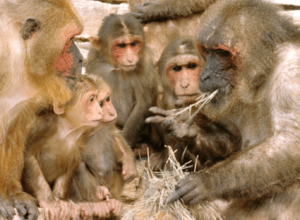Chewing facts for kids
Chewing, also known as mastication, is the process where you use your teeth to crush and grind food. It's the very first step of digestion. Chewing breaks food into smaller pieces, which helps your body digest it better with special chemicals called enzymes.
Your cheeks and tongue help move the food around in your mouth, pushing it between your teeth so you can grind it up. Strong muscles in your jaw move your teeth up and down, making them meet and then open again. As you chew, the food gets softer and warmer. Your spit, called saliva, has special enzymes that start breaking down carbohydrates (sugars and starches) in the food.
Once chewed, the food becomes a soft ball called a bolus. You swallow it, and it goes down a tube called the esophagus. From there, it moves to your stomach, where the next part of digestion happens.
Sometimes, human parents chew food for their babies who can't chew yet. This is called premastication. The parent chews the food into a soft ball and then gives it to the baby. Some animals do this too.
Animals like cows and other ruminants chew their food more than once to get all the nutrients out. After the first chew, this food is called cud.
Contents
How Chewing Works
Chewing is mostly something your body does without you thinking about it. It's like breathing or your heart beating. However, you can also decide to chew more or less. Your brain has a special "chewing program" that controls how your jaw muscles work.
This program learns and adjusts based on the type of food you're eating or if your teeth change. For example, if you get new dentures (false teeth), your brain might need to learn how to chew with them.
Sometimes, people might chew too much without realizing it, especially when they are sleeping or feeling stressed. This can be a habit called parafunction.
Chewing for Health
Chewing is important for your health and getting enough nutrients. Studies show that some foods, like meat and vegetables, need to be chewed well to be digested properly. Other foods, like cheese or fish, don't need as much chewing.
Chewing also helps your mouth make more saliva. Saliva helps you taste your food better and tells your body when it's time to swallow. If someone can't chew well, maybe because they've lost teeth, they might eat a "soft diet." This kind of diet might mean they don't eat enough fruits and vegetables, which are important for health.
Chewing also helps a part of your brain called the hippocampus work normally. The hippocampus is important for memory and learning.
Chewing in Animals
Chewing is very common in mammals, especially those that eat plants (herbivores). Animals that eat meat (carnivores) usually chew very little or swallow their food whole or in big pieces. This is why we say someone "wolfed down" their food if they eat it very quickly without chewing.
Long ago, a group of dinosaurs called Ornithopods, which included the "duck-billed" dinosaurs, developed teeth that were similar to mammal teeth. These special teeth helped them chew tough plants and get more nutrients. This might have helped them become very successful animals until a big event wiped out many dinosaurs.
Chewing Machines
Just like animals chew, some machines are designed to "chew" things too! For example, the United States Forest Service uses a machine called a masticator. This machine "chews" through bushes and trees to clear paths. These paths, called firelines, help stop wildfires from spreading.
Images for kids
See also
 In Spanish: Masticación para niños
In Spanish: Masticación para niños



